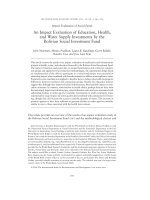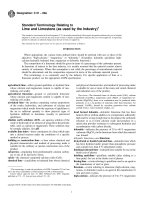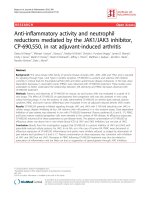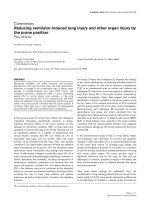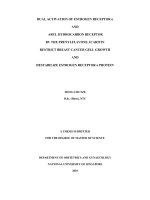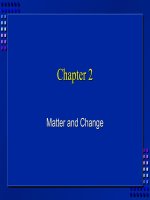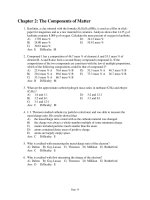Glencoe chemistry matter and change, reviewing chemistry by the princeton review
Bạn đang xem bản rút gọn của tài liệu. Xem và tải ngay bản đầy đủ của tài liệu tại đây (1.3 MB, 56 trang )
Reviewing Chemistry
Student Edition
A Glencoe Program
This booklet was written by The Princeton Review, the nation’s leader in test
preparation. The Princeton Review helps millions of students every year prepare for
standardized assessments of all kinds. Through its association with Glencoe/McGrawHill, The Princeton Review offers the best way to help students excel on the
Chemistry: Matter and Change Program.
The Princeton Review is not affiliated with Princeton University or Educational Testing Service.
Glencoe/McGraw-Hill
Copyright © The McGraw-Hill Companies, Inc. All rights reserved. Permission is granted to reproduce material contained herein on
the condition that such material be reproduced only for classroom use; and be provided to students, teachers, and families without
charge; and be used solely in conjunction with Chemistry: Matter and Change. Any other reproduction, for use or sale, is
prohibited without written permission of the publisher.
Send all inquiries to:
Glencoe/McGraw-Hill
8787 Orion Place
Columbus, OH 43240-4027
0-07-824550-8
Printed in the United States of America
1 2 3 4 5 6 7 8 9 045 06 05 04 03 02 01
CONTENTS
Student Introduction ............................................................................iv
CHAPTER REVIEW QUESTIONS
Chapter 1: Introduction to Chemistry ................................................1
Chapter 2: Data Analysis ......................................................................3
Chapter 3: Matter—Properties and Changes ......................................5
Chapter 4: The Structure of the Atom ................................................7
Chapter 5: Electrons in Atoms..............................................................9
Chapter 6: The Periodic Table and Periodic Law ................................11
Chapter 7: The Elements ......................................................................13
Chapter 8: Ionic Compounds ..............................................................15
Chapter 9: Covalent Bonding ..............................................................17
Chapter 10: Chemical Reactions ..........................................................19
Chapter 11: The Mole............................................................................21
Chapter 12: Stoichiometry....................................................................23
Chapter 13: States of Matter ................................................................25
Chapter 14: Gases ..................................................................................27
Chapter 15: Solutions............................................................................29
Chapter 16: Energy and Chemical Change ........................................31
Chapter 17: Reaction Rates ..................................................................33
Chapter 18: Chemical Equilibrium ......................................................35
Chapter 19: Acids and Bases ................................................................37
Chapter 20: Redox Reactions................................................................39
Chapter 21: Electrochemistry ..............................................................41
Chapter 22: Hydrocarbons....................................................................43
Chapter 23: Substituted Hydrocarbons and Their Reactions ............45
Chapter 24: The Chemistry of Life ......................................................47
Chapter 25: Nuclear Chemistry ............................................................49
Chapter 26: Chemistry in the Environment........................................51
Introduction to the Student
Welcome to Reviewing Chemistry
This workbook is designed to strengthen your knowledge of the NSCS (National
Science Content Standards) and provide additional chapter content review of your
Glencoe textbook, Chemistry: Matter and Change.
For each chapter in the Glencoe textbook, Chemistry: Matter and Change, two pages
of chapter review questions have been provided. These questions are designed to test
your comprehension of chapter content and provide you with practice in the related skills
specified in the NSCS. All of the questions are in a multiple-choice format.
Your teacher will provide you with copies of an answer sheet to use when answering
the questions provided for each chapter of your textbook. To keep track of your answers,
you should always fill in the chapter number for the set of review questions you are
answering. Every chapter has between eight and eleven review questions, so not every
row of answer bubbles will always be used.
Remember, this workbook should not be used as an alternative to reviewing the
material in your textbook. The questions are designed to ensure that you are fully tested
on the NSCS objectives that relate to chemistry. This workbook will be of greatest
advantage to you when used as a “refresher” after you have reviewed each chapter in the
textbook. Your teacher should decide how this workbook could best be used to strengthen
your skills and overall knowledge of chemistry.
Copyright © Glencoe/McGraw-Hill, a division of The McGraw-Hill Companies, Inc.
iv
Chemistry: Matter and Change
Reviewing Chemistry
CHAPTER 1
Chapter Title to
Introduction
TKChemistry
Name:
Date:
Use the label below to answer question 1.
3
Nutrition Facts
Cereal
(59 g)
Nutrient
Cereal with
Nonfat Milk
(250 mL)
% Daily Value* % Daily Value*
Fat
Sodium
Potassium
Carbohydrate
2%
0%
6%
16%
Copyright © Glencoe/McGraw-Hill, a division of The McGraw-Hill Companies, Inc.
2
A
atmospheric pressure
B
density
C
gravitational force
D
magnetic field
2%
3%
12%
18%
*Percent Daily Values are based on a 2000-Calorie diet.
Your daily values may be higher or lower, depending on
your Calorie needs.
1
Rocks brought back from the moon weighed more
on Earth than they did on the moon because Earth
has a greater —
4
According to this label, which nutrient is NOT found
in cereal?
A police detective has confiscated as evidence some
chicken soup that he suspects might contain poison.
Which type of chemist would most likely assist him
in determining the contents of the soup?
A
Analytical chemist
A
Fat
B
Biochemist
B
Sodium
C
Organic chemist
C
Potassium
D
Physical chemist
D
Carbohydrate
For an experiment in which you are determining the
freezing point of an unknown chemical, you record
the temperature every minute for 20 minutes. In this
example, time is the —
A
control
B
dependent variable
C
independent variable
D
hypothesis
Reviewing Chemistry
5
Which of these chemicals does NOT occur in
nature?
A
Ammonia
B
Chlorofluorocarbon
C
Fluorine
D
Ozone
Chemistry: Matter and Change
1
CHAPTER 1
Introduction to Chemistry, continued
Name:
6
Date:
In the chemistry lab, chemicals that you are finished
working with should be —
7
A
poured into the sink
B
returned to their original containers
C
mixed together and dumped in a designated
container
D
disposed of as directed by your teacher
9
A scientist observes that the number of coyote
sightings in suburban areas has increased over the
last four years. In the process of forming a
hypothesis as to why this number has increased, she
would —
make a set of controlled observations
B
decide which variables can be controlled
C
pose a tentative hypothesis explaining what
was observed
D
analyze data to explain what was observed
A
Colliding nuclei to discover the smallest
particles that make up matter
B
Using the results of DNA profiling as evidence
in a court of law
C
Sending spacecraft to Mars to search for other
life forms
D
Testing chemicals to replace CFCs in air
conditioners and refrigerators
Test
Tube 1
Test
Tube 2
20ml
8
Which of these pieces of laboratory glassware
should NEVER be heated with a Bunsen burner?
2
15ml
20ml
20ml
20ml
20ml
Chemical X
A biochemist is performing an experiment to
determine the effects of Chemical X on the growth
of bacteria. Which is the control?
A
Test tube 1
A
Beaker
B
Test tube 2
B
Graduated cylinder
C
Test tube 3
C
Flask
D
Test tube 4
D
Test tube
Chemistry: Matter and Change
Test
Tube 4
10ml
Sterile
Beef Broth
10
Test
Tube 3
Reviewing Chemistry
Copyright © Glencoe/McGraw-Hill, a division of The McGraw-Hill Companies, Inc.
A
Which of the following is an example of applied
research?
CHAPTER 2
Chapter
Data
Analysis
Title TK
Name:
Date:
Use the graph below to answer questions 1
and 2.
2
Copyright © Glencoe/McGraw-Hill, a division of The McGraw-Hill Companies, Inc.
Mass (g)
Mass of Sodium Nitrate that Can Be
Dissolved in 100 mL of Water
160
150
140
130
120
110
100
90
80
70
60
50
40
30
20
10
0
3
Based on the information in the graph, what is the
approximate number of grams of sodium nitrate that
can be dissolved at a temperature of 90ºC?
A
150 g
B
155 g
C
160 g
D
165 g
In chemistry lab, a student was instructed to find the
density of a rectangular piece of aluminum. After
careful measurement, he recorded a mass of 31.44 g
and a volume of 11.7 cm3. Using the formula
density = massנvolume and a calculator, his answer
was 2.6871794 g/cm3. Which of these is the correct
answer to report for the density of the aluminum?
A
2.7 g/cm3
B
2.69 g/cm3
C
2.687 g/cm3
D
2.68 g/cm3
0 10 20 30 40 50 60 70 80 90 100
Temperature (°C)
1
According to these data, what is the approximate
number of grams of sodium nitrate that can be
dissolved at a temperature of 50ºC?
A
95 g
B
105 g
C
115 g
D
125 g
Reviewing Chemistry
Chemistry: Matter and Change
3
CHAPTER 2
Data Analysis, continued
Name:
Date:
Use the table below to answer questions
4 and 5.
6
Boiling Point Data Collected by Student Groups
Group A Group B Group C Group D
Trial 1
Trial 2
Trial 3
Average
4
79°C
78°C
83.5°C
80.2°C
82°C
84.5°C
79°C
81.8°C
75°C
83°C
78.5°C
78.8°C
80°C
80.5°C
79.5°C
80°C
The table shows the data obtained by four groups of
students during a lab investigation designed to
determine the boiling point of methanol. The
accepted value for the boiling point of methanol is
78.5ºC. Whose data was the most accurate?
Group A
B
Group B
C
Group C
D
Group D
7
B
3 tablespoons
2 teaspoons
C
4 tablespoons
1/4 cup
D
1/4 cup
4 tablespoons
A student told the class that she takes 500 mg of
vitamin C every day. What is this mass expressed in
grams?
A
0.05 g
B
0.5 g
C
5.0 g
D
500,000 g
Whose data was the most precise?
4
A
Group A
B
Group B
C
Group C
The density of carbon dioxide gas is 1.8ן10–3
g/cm3. This value can be expressed in ordinary
notation as —
D
Group D
A
0.0018 g/cm3
B
0.018 g/cm3
C
0.18 g/cm3
D
1.800 g/cm3
Chemistry: Matter and Change
8
Reviewing Chemistry
Copyright © Glencoe/McGraw-Hill, a division of The McGraw-Hill Companies, Inc.
5
A
Sandra has a recipe for cookies that calls for 4
tablespoons of peanut oil. If she wants to triple the
recipe, which conversion factor would be helpful?
3 teaspoons
A
1 tablespoon
CHAPTER 3
Matter—Properties
and Changes
Name:
Date:
Use the tables below to answer questions 1
and 2.
3
Baking Soda Analysis
Element
Analysis by Mass
% by Mass
Oxygen
Sodium
Hydrogen
Carbon
Total
114.20 g
54.80 g
2.40 g
?
200.00 g
57.1%
27.4%
1.2%
14.3%
100%
Sodium Hydrogen Carbonate Analysis
Copyright © Glencoe/McGraw-Hill, a division of The McGraw-Hill Companies, Inc.
Element
Oxygen
Sodium
Hydrogen
Carbon
Total
1
2
Analysis by Mass
28.55 g
13.70 g
0.60 g
7.15 g
50.00 g
% by Mass
57.1%
27.4%
1.2%
14.3%
100%
4
Which of these phase changes does NOT involve the
absorption of heat energy?
A
Boiling
B
Condensation
C
Melting
D
Vaporization
In the periodic table, a series of elements that is
arranged in a horizontal row is called a —
A
cluster
B
family
C
period
D
group
The tables show the chemical analyses of two compounds: baking soda and sodium hydrogen carbonate.
Because they have the same percent by mass, they
must be the same compound according to the —
A
law of definite proportions
B
law of multiple proportions
C
law of conservation of energy
D
law of conservation of mass
If baking soda and sodium hydrogen carbonate are
the same compound, then the mass of carbon in
200.00 g of baking soda should be —
A
7.15 g
B
14.30 g
C
28.6 g
D
57.20 g
Reviewing Chemistry
5
Distillation is a separation technique that involves —
A
using a porous barrier to separate a solid from a
liquid
B
separating dissolved substances based on their
tendency to be drawn across a surface
C
the formation of pure, solid particles of a
substance from a solution containing the
dissolved substance
D
separating two or more liquids based on
differences in their boiling points
Chemistry: Matter and Change
5
CHAPTER 3
Matter—Properties and Changes, continued
Name:
Date:
Use the diagram below to answer questions 6
and 7.
36.5 g
HCl
+ NaOH
hydrochloric
acid
6
sodium
hydroxide
Characteristics of a substance can be classified as
physical properties or chemical properties. Which of
the following is a chemical property?
A
Boils at 56ºC
NaCl + H2O
B
Tastes sour
water
C
Has a density of 2.9 g/cm3
D
Reacts with acid to produce hydrogen gas
58.5 g
40.0 g
8
sodium
chloride
?g
The diagram shows a chemical equation representing
a chemical reaction. The name and mass of each
substance involved in the chemical reaction are also
shown. Which of these are the reactants?
A
HCl and NaOH
B
NaCl and H2O
C
HCl and H2O
D
NaOH and NaCl
Use the diagrams below to answer question 9.
9
7
According to the law of conservation of mass, mass
is neither created nor destroyed during a chemical
reaction. On the basis of this law, what mass of
water was produced in this reaction?
6
R
T
Each diagram shows the particles of a substance in a
closed container. Which of these shows the substance
that is most easily compressed?
A
Q
A
16.0 g
B
R
B
18.0 g
C
S
C
20.0 g
D
T
D
22.0 g
Chemistry: Matter and Change
S
Reviewing Chemistry
Copyright © Glencoe/McGraw-Hill, a division of The McGraw-Hill Companies, Inc.
Q
CHAPTER 4
The Structure of the Atom
Name:
Date:
Use the diagram below to answer question 1.
+
+
+
+
92 p + +
proton (p) +
neutron (n) 146 n
+
+
+
+
uranium-238 nucleus daughter
(parent nucleus)
nucleus
++
Use the chart below to answer questions
3 and 4.
2p
2n
Element Atomic Isotope
#
helium-4 nucleus
(alpha particle)
hydrogen
hydrogen-1
hydrogen-2
1.01 amu
2.01 amu
99.985
0.015
6
carbon-12
carbon-13
carbon-14
12.00 amu
13.00 amu
14.00 amu
98.90
1.09
0.01
8
oxygen-16
oxygen-17
oxygen-18
15.99 amu
17.00 amu
18.00 amu
98.90
0.038
0.200
copper-63
copper-65
62.94 amu
64.93 amu
69.17
30.83
1
carbon
Copyright © Glencoe/McGraw-Hill, a division of The McGraw-Hill Companies, Inc.
1
2
The diagram above illustrates a nuclear reaction in
which uranium-238 emits an alpha particle. How
many protons and neutrons will the daughter
nucleus have?
A
90 p and 144 n
B
92 p and 142 n
C
92 p and 150 n
D
94 p and 148 n
oxygen
copper
29
3
In his latest dig, Dr. Butrell found an abundance of
lead (Pb) in some ancient artifacts. What is the
atomic number of Pb?
A
80
B
81
C
82
D
83
Reviewing Chemistry
4
%
Atomic mass
of isotope abundance
The chart shows isotopes of some common elements.
Which property is used to name the isotopes?
A
Atomic number
B
Atomic mass
C
Mass number
D
Percent natural occurrence
The atomic mass of an element is the weighted
average mass of the isotopes of that element. Based
on this definition, which of these does NOT show
the correct atomic mass for an element?
A
Hydrogen: 1.008 amu
B
Carbon: 12.011 amu
C
Oxygen: 15.999 amu
D
Copper: 63.017 amu
Chemistry: Matter and Change
7
CHAPTER 4
The Structure of the Atom, continued
Name:
Date:
Use the diagram below to answer question 5.
Use the diagram below to answer question 7.
rays
alpha particle
+
—nucleus of gold atom
paths of
alpha particles
+
+
rays
rays
+
-
+
+
5
The diagram above shows the results of Rutherford’s
experiment in which he used a radioactive source to
“shoot” alpha particles at a thin sheet of gold foil.
Based on these results, what were Rutherford’s
conclusions?
Atoms are solid matter with positive and
negative charges scattered throughout.
B
Atoms are solid, positively charged matter with
negatively charged electrons scattered
throughout.
C
Atoms are mostly empty space with small,
dense, positively charged centers.
D
Atoms are mostly empty space with small,
dense, negatively charged centers.
7
8
6
The cathode ray tube is a key component of which of
the following revolutionary inventions?
8
A
Automobile
B
Fax machine
C
Television
D
Photocopier
Chemistry: Matter and Change
radioactive
substance
The diagram above shows how alpha, beta, and
gamma rays are affected by two electrically charged
plates. Based on the paths the rays follow, what are the
respective charges of alpha, beta, and gamma rays?
A
negative, positive, none
B
positive, negative, none
C
negative, none, positive
D
positive, none, negative
In the fourth century BC, Greek scholars rejected
Democritus’s ideas about the atom. This rejection
was most likely based on —
A
experimentation
B
government legislation
C
religious beliefs
D
the popularity of Aristotle’s ideas on nature
Reviewing Chemistry
Copyright © Glencoe/McGraw-Hill, a division of The McGraw-Hill Companies, Inc.
A
lead shield
CHAPTER 5
Electrons in Atoms
Name:
Date:
In question 1, the speed of light, c, equals
3.00 ϫ 108 m/s.
3
Yellow light has a wavelength of 5.60 ן10–7
meters. According to the formula, c = , what is the
frequency of this yellow light?
1
A
5.36 ן1014 s–1
B
5.36 ן1016 s–1
C
1.87 ן10–15 s–1
D
1.87 ן1015 s–1
Use the diagram below to answer question 2.
Copyright © Glencoe/McGraw-Hill, a division of The McGraw-Hill Companies, Inc.
1
2
3
4
5
6
7
8
9
10
11
12
13
14
wavelength
2
What is the wavelength of the wave shown above?
A
3.2 cm
B
3.5 cm
C
3.7 cm
D
4.0 cm
Reviewing Chemistry
A
the release of gamma rays from the nucleus
B
the return of excited electrons to lower energy
levels
C
the movement of electrons to higher energy
levels
D
the absorption of photons by the electrons
In question 4, Planck’s constant, h, equals
6.626 ϫ 10–34 J.s
4
0
When a potassium compound is placed in a flame,
energy is released and a violet color is produced.
This energy release is due to —
According to Einstein, Ephoton = h. What is the
energy of a photon if it has a frequency of
6.82 ן1014s–1?
A
9.72 ן10–20J
B
1.03 ן10–20J
C
4.52 ן10–19J
D
4.52 ן10–20J
Chemistry: Matter and Change
9
CHAPTER 5
Electrons in Atoms, continued
Name:
5
Date:
Which of these is the ground-state electron
configuration for an atom of fluorine (atomic
number = 9)?
A
1s22s2
B
1s22s22p3
C
1s22s22p4
D
1s22s22p5
7
Which of these orbital diagrams represents a
chlorine atom in the ground state? Chlorine has an
atomic number of 17.
A
B
C
6
The electron configuration for an atom of iron is
[Ar] 3d64s2. Which of the following is the correct
electron-dot structure for iron?
Fe
B
Fe
C
Fe
D
10
Fe
Chemistry: Matter and Change
8
2p
1s 2s
2p
1s 2s
2p
3s
3p
1s 2s
2p
3s
3p
The arrangement of electrons in an atom of an
element determines the chemical properties of that
element. Our present-day understanding of how
electrons are arranged in an atom is the result of all
of these scientific contributions EXCEPT —
A
Rutherford’s gold foil experiment that proved
the existence of the nucleus
B
Bohr’s orbits that explained hydrogen’s
quantized energy states
C
De Broglie’s equation that led to thinking of
electrons as both particles and waves
D
Schrưdinger’s wave equation that predicted
atomic orbitals
Reviewing Chemistry
Copyright © Glencoe/McGraw-Hill, a division of The McGraw-Hill Companies, Inc.
A
D
1s 2s
CHAPTER 6
The Periodic Table and
Periodic Law
Name:
Date:
Use the graph below to answer questions 1–3.
3
Why are there no electronegativity values for the
elements with atomic numbers 2, 10, and 18?
A
The noble gases form very few compounds
because they are gases.
B
The noble gases form very few compounds
because they are rare.
C
The noble gases form very few compounds
because they are radioactive.
D
The noble gases form very few compounds
because their electron configurations are
very stable.
Electronegativity
5
4
3
2
1
0
1 2 3 4 5 6 7 8 9 10 11 12 13 14 15 16 17 18 19 20
Atomic Number
1
The electronegativity of an element indicates the
relative ability of its atoms to attract electrons to
form chemical bonds. According to the graph, as you
move across a period in the periodic table —
Copyright © Glencoe/McGraw-Hill, a division of The McGraw-Hill Companies, Inc.
A
the atomic number increases and the
electronegativity increases
B
the atomic number increases and the
electronegativity decreases
C
the atomic number decreases and the
electronegativity increases
D
4
A
brittle
B
solid
C
dull
D
gaseous
the atomic number decreases and the
electronegativity decreases
5
2
Metal is to malleable as nonmetal is to —
Elements in the same group of the periodic table
have similar chemical properties because they
have —
According to the graph, which of the following
elements has the strongest attraction for electrons?
A
the same number of orbitals
A
Aluminum (atomic number = 13)
B
the same number of valence electrons
B
Boron (atomic number = 5)
C
atomic numbers that are multiples of each other
C
Oxygen (atomic number = 8)
D
the same principal energy levels
D
Sulfur (atomic number = 16)
Reviewing Chemistry
Chemistry: Matter and Change
11
CHAPTER 6
The Periodic Table and Periodic Law, continued
Name:
Date:
Ionization Energy (kcal/mol)
Use the graph below to answer questions
6 and 7.
8
600
550
500
450
400
350
300
250
200
150
100
50
0
3
4
5
6
7
8
Mendeleev left blank spaces in his periodic table
where he thought elements that had not yet been
discovered should go. He was able to predict the
properties of these elements by —
A
studying the spectra of stars that contained them
B
testing their properties such as melting point,
density, and valence
C
noting periodic trends in the properties of
known elements that surrounded the blank
spaces in the periodic table
D
studying the new elements produced by
radioactive decay
9 10 11 12 13 14 15 16 17 18 19 20
Atomic Number
6
12
A
300 kcal/mol
B
250 kcal/mol
C
240 kcal/mol
D
190 kcal/mol
Use the diagram below to answer question 9.
PERIODIC TABLE
the principal energy level increases and the first
ionization energy increases
B
the principal energy level increases and the first
ionization energy decreases
C
the principal energy level decreases and the first
ionization energy increases
D
the principal energy level decreases and the first
ionization energy decreases
Chemistry: Matter and Change
13 14 15 16 17
2
Y
Y
Y
Y
Y
Y
3
Z
Z
Z
Z
W
4 5 6 7 8 9 10 11 12 W
Z Z Z Z Z Z Z Z Z W
Z Z Z Z Z Z Z Z Z W
Z Z Z Z Z Z Z Z Z W
Z Z
W
W
W
W
W
W
W
W
W
W
W
W
W
W
W
W
W
W
W
W
Y
W
W
W
W
W
X X X X X X X X X X X X X X
X X X X X X X X X X X X X X
Elements with atomic numbers 4, 12, and 20 are in
the same group in the periodic table. As you move
down a group —
A
18
1
Y
Y
Y
Y
Y
Y
Y
9
The periodic table has an unusual shape because it is
divided into blocks representing the energy sublevel
being filled with valence electrons. In the periodic
table shown in the diagram, which sequence lists
these blocks in s-p-d-f order?
A
Y, W, Z, X
B
W, Y, X, Z
C
Y, Z, W, X
D
X, Y, Z, W
Reviewing Chemistry
Copyright © Glencoe/McGraw-Hill, a division of The McGraw-Hill Companies, Inc.
7
The graph shows the first ionization energy for
elements with atomic numbers 3–20. According to
the graph, what is the approximate first ionization
energy for the element with atomic number 16?
CHAPTER 7
The Elements
Name:
Date:
Use the diagram below to answer question 1.
Protium
Deuterium
3
Tritium
Scuba tanks usually contain compressed air, which is
essentially a mixture of nitrogen (78%) and oxygen
(21%). In order to avoid a painful condition called
the “bends,” deep-sea divers replace the nitrogen
with the noble gas —
A
helium
B
argon
C
krypton
D
xenon
Proton
Electron
Neutron
Copyright © Glencoe/McGraw-Hill, a division of The McGraw-Hill Companies, Inc.
1
Some nuclear reactors use heavy water to slow down
neutrons produced during nuclear fission. Heavy
water contains deuterium, an isotope of hydrogen.
What is the mass number of deuterium?
A
1
B
2
C
3
D
4
Use the diagram below to answer question 4.
1
1
1
H
2
1.0079
2
3
Li
4
Be
6.941 9.0122
11
Na
3
12
Mg
22.990 24.305
2
A family of colorless, inactive gases was unknown at
the time Mendeleev conceived his periodic table.
Eventually, these gases were discovered on Earth in
the late 1890s. What group does this family occupy
in the modern periodic table?
A
5A
B
6A
C
7A
D
8A
Reviewing Chemistry
4
Lithium (Li), an alkali metal, has properties similar
to and has a diagonal relationship with —
A
hydrogen (H)
B
beryllium (Be)
C
sodium (Na)
D
magnesium (Mg)
Chemistry: Matter and Change
13
CHAPTER 7
The Elements, continued
Name:
5
6
14
Iron is to hemoglobin as magnesium is to —
A
amino acid
B
chlorophyll
C
DNA
D
protein
8
As you move from top to bottom down a group in
the periodic table, which of the following happens?
A
Valence electrons move farther from the
positively charged nucleus.
B
Valence electrons move farther from the
negatively charged nucleus.
C
Valence electrons move closer to the positively
charged nucleus.
D
Valence electrons move closer to the negatively
charged nucleus.
Transition metals with unpaired valence electrons are
attracted to a magnetic field. Which of these
elements is NOT able to form a permanent magnet?
A
Cobalt
B
Copper
C
Nickel
More than three times as much energy is used to
make a new aluminum can than to process a recycled
one. The main reason for this difference is that—
D
Iron
A
aluminum is not an abundant element
B
aluminum has a high melting point
C
it is difficult to extract aluminum from its ore
D
aluminum is not a reactive metal
9
In the periodic table, as you move from left to right
across a period —
A
atomic radius increases and ionization energy
increases
B
atomic radius increases and ionization energy
decreases
C
atomic radius decreases and ionization energy
increases
D
atomic radius decreases and ionization energy
decreases
Chemistry: Matter and Change
Reviewing Chemistry
Copyright © Glencoe/McGraw-Hill, a division of The McGraw-Hill Companies, Inc.
7
Date:
CHAPTER 8
Ionic Compounds
Name:
1
Date:
Which of these is NOT a cation?
3
An atom with the electron configuration 1s22s22p6
3s23p64s2 is most likely —
A
Na+
B
Cl–
A
a metal that forms a positive ion
C
Mg2+
B
a metal that forms a negative ion
D
K+
C
a nonmetal that forms a positive ion
D
a nonmetal that forms a negative ion
Use the diagram below to answer question 2.
Use the table below to answer question 4.
+
-
+
+ Copyright © Glencoe/McGraw-Hill, a division of The McGraw-Hill Companies, Inc.
+
-
+
+
+ -
-
- +
+
+
electron
+
-
-
+
+ -
-
+
-
Compound
NaCl
KBr
LiF
MgO
+
positive ion
4
2
The diagram represents the arrangement of atoms in
a metallic solid. Scientists believe that electrons in
the outer energy levels of the bonding metallic atoms
are free to move from one atom to the next. Because
they are free to move, these electrons are often
referred to as —
The table shows the lattice energy for some ionic
compounds. Based on these data, which of these
compounds would require the most energy to
separate the bonded ions?
A
NaCl
B
KBr
A
delocalized electrons
C
LiF
B
lattice electrons
D
MgO
C
malleable electrons
D
valence electrons
Reviewing Chemistry
Lattice Energy (kJ/mol)
–769
–671
–1030
–3795
Chemistry: Matter and Change
15
CHAPTER 8
Ionic Compounds, continued
Name:
Date:
Use the diagram below to answer question 5.
6
When atoms of sodium (Na) and chlorine (Cl)
combine to form salt (NaCl), an ionic crystal is
formed. The Na+ ion is smaller than the Na atom,
while the Cl– ion is larger than the Cl atom. Why?
A
The Na and the Cl atoms both lost electrons.
B
The Na and the Cl atoms both gained electrons.
C
The Na atom lost an electron, while the Cl atom
gained an electron.
D
The Na atom gained an electron, while the Cl
atom lost an electron.
Ionic
Compound
7
5
CaCl
B
A
the formation of an ionic compound is an
exothermic reaction
Ca2Cl
C
CaCl2
B
ionic compounds are electrolytes
D
Ca2Cl2
C
ions have an electrical charge
D
water is a good conductor of electricity
8
16
A
Chemistry: Matter and Change
Most transition metals have more than one oxidation
number because —
A
they may lose d electrons when forming positive
ions
B
they may lose f electrons when forming ions
C
their electron arrangements are unstable
D
their electrons are closer to the nucleus
Reviewing Chemistry
Copyright © Glencoe/McGraw-Hill, a division of The McGraw-Hill Companies, Inc.
This apparatus was most likely designed to show
that —
What is the chemical formula for a compound
formed from calcium ions (Ca2+) and chloride ions
(Cl–)?
CHAPTER 9
Covalent Bonding
Name:
1
Date:
A molecule is formed when two or more atoms form
a covalent bond. According to this definition, which
of these is NOT a molecule?
A
NaCl
B
H2
C
HCl
D
NH3
3
In the polyatomic ion NH4+, the formation of a
coordinate covalent bond between nitrogen and
hydrogen involves —
A
hydrogen transferring a pair of electrons to
nitrogen
B
nitrogen transferring a pair of electrons to
hydrogen
C
hydrogen donating a pair of electrons to be
shared with nitrogen
D
nitrogen donating a pair of electrons to be
shared with hydrogen
Use the table below to answer question 2.
Copyright © Glencoe/McGraw-Hill, a division of The McGraw-Hill Companies, Inc.
Number
Number
of Atoms Prefix of Atoms Prefix
1
2
3
4
5
2
monoditritetrapenta-
6
7
8
9
10
hexaheptaoctanonadeca-
4
When hydrogen and fluorine combine, a polar
covalent bond is formed. Which of these formulas is
the best way to express this relationship?
A
H–F
B
␦+ H – F␦–
The table shows some of the prefixes used to name
binary covalent compounds. What name would be
given to the compound PBr5?
C
H F
A
Phosphorus tetrabromide
D
HF
B
Monophosphorus pentabromide
C
Phosphorus pentabromide
D
Phosphorus hexabromide
Reviewing Chemistry
Chemistry: Matter and Change
17
CHAPTER 9
Covalent Bonding, continued
Name:
5
Date:
At room temperature, iodine (I2) is a solid and
bromine (Br2) is a liquid. These molecules have
different melting points because of stronger —
A
covalent bonds in iodine
B
covalent bonds in bromine
C
intermolecular forces in iodine
D
intermolecular forces in bromine
Use the diagram below to answer question 6.
Normal
1s 2s
1s 2s
18
s2 orbital
B
sp orbital
C
sp2 orbital
D
sp3 orbital
A
H2S
B
H2SO3
C
H2SO4
D
H2S
The bond that holds two fluorine atoms together in
an F2 molecule would be classified as nonpolar
covalent because —
A
both atoms are different and the difference in
electronegativity is large
B
both atoms are different and the difference in
electronegativity is zero
C
both atoms are the same and the difference in
electronegativity is large
D
both atoms are the same and the difference in
electronegativity is zero
2p
2p
Hybridized
The diagram shows the electron configuration of a
normal carbon atom and the rearrangement of
electrons to form four new identical orbits in a
hybridized carbon atom. This type of hybrid orbital
is called an —
A
8
Which of these is the chemical formula for
sulfurous acid?
Chemistry: Matter and Change
Reviewing Chemistry
Copyright © Glencoe/McGraw-Hill, a division of The McGraw-Hill Companies, Inc.
6
7
CHAPTER 10
Chemical Reactions
Name:
Date:
Refer to the diagram below to answer
questions 1–6.
Zn(s) + HCl(aq)
Copyright © Glencoe/McGraw-Hill, a division of The McGraw-Hill Companies, Inc.
1
2
3
ZnCl2(aq) + H2(g)
The chemical reaction represented by the equation
would be classified as a —
A
synthesis reaction
B
decomposition reaction
C
single-replacement reaction
D
double-replacement reaction
The skeleton equation represents a chemical
reaction. Which of these are the reactants?
A
Zn and HCl
B
ZnCl2 and H2
C
HCl and ZnCl2
D
Zn and H2
The skeleton equation for this chemical reaction
violates the law of conservation of mass. Which of
these is the correct balanced chemical equation?
A
2Zn(s) + HCl(aq) ➝ 2ZnCl2(aq) + H2(g)
B
Zn(s) + 2HCl(aq) ➝ ZnCl2(aq) + 2H2(g)
C
Zn(s) + 2HCl(aq) ➝ ZnCl2(aq) + H2(g)
D
2Zn(s) + 2HCl(aq) ➝ 2ZnCl2(aq) + H2(g)
Reviewing Chemistry
4
HCl(aq) and ZnCl2(aq) both exist as ions in aqueous
solutions. Which of these is the complete ionic
equation for this chemical reaction?
A
Zn(aq) + 2H+(aq) + Cl–(aq) ➝
Zn2+(aq) + Cl–(aq) + H2(g)
B
Zn(s) + 2H+(aq) + 2Cl–(aq) ➝
Zn2+(aq) + 2Cl–(aq) + H2(g)
C
2Zn(s) + H+(aq) + Cl–(aq) ➝
2Zn2+(aq) + Cl–(aq) + H2(g)
D
Zn(aq) + 2H+(aq) + 2Cl–(aq) ➝
Zn2+(s) + Cl–(aq) + 2H2(g)
Chemistry: Matter and Change
19
CHAPTER 10
Chemical Reactions, continued
Name:
5
6
20
Which of these is a spectator ion in this chemical
reaction?
A
Cl–(aq)
B
H+(aq)
C
H2(g)
D
Zn2+(aq)
Use the diagram below to answer question 8.
K
Ca
Na
Mg
Al
Zn
Fe
Pb
H
Cu
Ag
Increasing
ease of
discharge
OH
I
Br
Cl
NO3
SO4
Increasing
ease of
discharge
Which of these is the net ionic equation for this
chemical reaction?
A
Zn(s) + 2Cl–(aq) ➝ Zn2+(aq) + 2Cl–(aq)
B
Zn2+(aq) + 2H+(aq) ➝ Zn(s) + H2(g)
C
2H+(aq) + 2Cl–(aq) ➝ 2HCl(aq)
D
Zn(s) + 2H+(aq) ➝ Zn2+(aq) + H2(g)
Which of these is NOT evidence of a chemical
reaction?
A
An iron nail changes to a brownish-orange color.
B
An ice cube melts into liquid water.
C
An antacid tablet produces bubbles of gas when
placed in water.
D
A piece of zinc raises the temperature of an acid
as it reacts with it.
Chemistry: Matter and Change
8
The diagram shows the activity series of some
metals (left) and nonmetals (right). A student set up
four beakers, each containing 100 mL of dilute
hydrochloric acid (HCl[aq]). She added 5 g of a
metal to each beaker in this order: aluminum (Al),
copper (Cu), sodium (Na), and zinc (Zn). Which
metal will NOT react with the acid?
A
Aluminum
B
Copper
C
Sodium
D
Zinc
Reviewing Chemistry
Copyright © Glencoe/McGraw-Hill, a division of The McGraw-Hill Companies, Inc.
7
Date:
CHAPTER 11
The Mole
Name:
1
Date:
How many moles of nitrogen atoms are contained in
one mole of Ba(NO3)2?
A
1
B
2
C
6
D
9
4
5
Copyright © Glencoe/McGraw-Hill, a division of The McGraw-Hill Companies, Inc.
2
The molecular formula of a compound is X6Y3. What
is the empirical formula for this compound?
A
amu
B
mass
C
molecule
D
particle
What is the total number of atoms contained in 2.00
moles of helium?
A
15.999
A
X6Y
B
32.0
B
XY3
C
6.02 ן1023
C
X2Y
D
1.20 ן1024
D
XY2
6
3
Mole is to atom as gram is to —
Zinc is used as a coating on iron and steel to prevent
corrosion. What is the mass, in grams, of 0.0650
mol Zn?
A compound has the formula MgSO4•7H2O. Its
chemical name is —
A
aqueous magnesium sulfate
A
3.25 g
B
magnesium sulfate pentahydrate
B
3.90 g
C
magnesium sulfate heptahydrate
C
3.94 g
D
magnesium sulfate decahydrate
D
4.25 g
Reviewing Chemistry
Chemistry: Matter and Change
21

